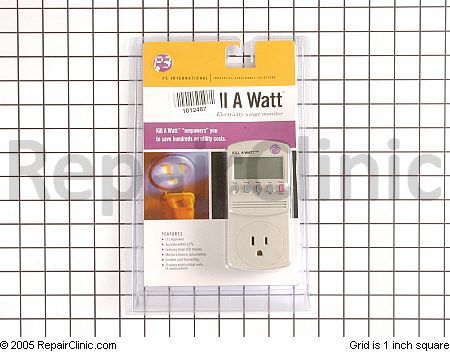 Many grasshoppers often ask me, "Oh, most wise and beloved Samurai, which appliances use the most power and what can be done to make them more efficient?" To which I sagely reply, "Look, I’m Samurai Appliance Repair Man, not a friggin’ power meter. How ’bout you measure the power usage of your appliances yourself?" Yes, grasshopper, until recently, power consumption test instruments were very expensive. However, a new product, called the Kill-a-Watt meter can help you determine which appliance is hogging the most energy in your home.
Many grasshoppers often ask me, "Oh, most wise and beloved Samurai, which appliances use the most power and what can be done to make them more efficient?" To which I sagely reply, "Look, I’m Samurai Appliance Repair Man, not a friggin’ power meter. How ’bout you measure the power usage of your appliances yourself?" Yes, grasshopper, until recently, power consumption test instruments were very expensive. However, a new product, called the Kill-a-Watt meter can help you determine which appliance is hogging the most energy in your home.

Is your refrigerator running too much, or is your window air conditioner causing your electric bill to skyrocket? With the Kill-a-Watt meter, you can determine energy usage of any standard household appliance that plugs into a 110 volt outlet.
Refrigerators use a lot of power — between 300 and 500 watts while running. If the condenser coil is dirty, or the door gaskets are torn, they’ll use even more. Check the efficiency of your refrigerator and other appliances regularly, and clean or maintain them as needed to make sure they’re running as efficiently as possible.
You can also use the Kill-a-Watt meter to check computers, table lamps and most other devices that plug into standard wall receptacles. You’ll learn many devices, such as TVs and stereos, actually use energy when they’re turned off.
The Kill-a-Watt meter costs less than $30. This is a small price to pay to potentially save hundreds of dollars in electricity over time. Come git you one!

 Excellent question, thanks for asking! This is a point of confusion for many grasshoppers. The rule for using plumber’s (teflon) tape is to apply it only to Male Pipe Threads (also called "Male Iron Pipe" or MIP)–never to flare connection threads. This is illustrated in this picture. More information on gas connections here.
Excellent question, thanks for asking! This is a point of confusion for many grasshoppers. The rule for using plumber’s (teflon) tape is to apply it only to Male Pipe Threads (also called "Male Iron Pipe" or MIP)–never to flare connection threads. This is illustrated in this picture. More information on gas connections here. ![]()





